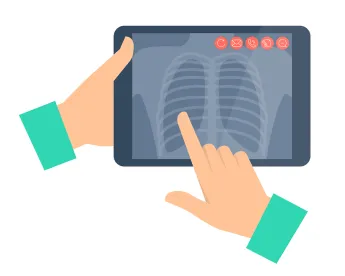There is an increasing demand for services, including digital solutions, that assist patients in finding cost-efficient medical care. These products raise potential legal hurdles to the extent that provider payments for these services could be intended to induce or reward the referrals of patients to the providers. The Office of Inspector General ("OIG") has recently released Advisory Opinion No. 1904 (the "Opinion") that provides helpful insights on an online healthcare directory, an arrangement that is particularly noteworthy for its incorporation of per-click and per-booking fees.1 This Legal Update analyzes the Opinion and its applicability to other similar products and technology prevalent in the marketplace.
The requestor in the Opinion maintains an online directory for searching and booking medical appointments. Patients wishing to obtain health care services enter personal information (e.g. medical condition, insurance, location); the service then generates, through the requestor's proprietary algorithm, a list of medical providers that match the patient's needs. Providers must pay to be included in the directory and for sponsored advertisements appearing in the directory and third-party websites. The payment structure for inclusion in the directory varies slightly from state-to-state but typically involves both a flat fee and an additional per-booking fee. The requestor's goal is to have all fees for directory inclusion be per-booking. Providers may also purchase sponsored listings, which result in a more prominent display when the provider appears in a patient's search results.
The Opinion analyzed this arrangement under the civil monetary penalty provisions of the Social Security Act ("CMP") and under the federal anti-kickback statute ("AKS"). The CMP imposes penalties against any person who offers or transfers something of value to a federal health care program beneficiary that is likely to influence the beneficiary's selection of a provider. The intent of the CMP is to ensure that beneficiaries choose their providers based on quality, availability and cost rather than based on improper inducements. While OIG recognized that the directory provides something of value to beneficiaries in its functionality and convenience, OIG concluded that this would likely not influence a beneficiary to select a particular provider. Other considerations such as the beneficiaries' relationships and experiences with providers would be just as likely to inform their choice.
AKS concerns required a deeper analysis in the Opinion. The AKS is implicated whenever anything of value is offered or paid with the intent to induce referrals of services payable by a federal healthcare program. The AKS seeks to ensure that the free market decides where referrals are sent, because that is likely to be in the best interest of the beneficiary, whereas kickbacks may lead to referrals in the best interest of the referrer. Using the OIG's factor analysis for marketing or advertising activities under the AKS, the Opinion noted as follows:
- The fees are structured so that increases in fee payments (due to increases in patient clicks) do not lead to more frequent appearances in search results from patient queries. Appearances in search results depend only on user-centric criteria. The advertising fees do result in more prominent placement in search results, but the fees are based on bidding among the providers, not based on referrals or insurance status.
- The requester is not a healthcare professional, provider, or supplier. Arrangements with such individuals are subject to heightened scrutiny since they are in a position to potentially exert undue influence.
- The requestor's marketing is passive since patients must initiate the contact. Direct contact initiated by the requester would be more suspect.
- No specific item or service is being promoted. The Opinion notes that the sponsored results could be interpreted as promoting a particular provider, but OIG did not appear to be concerned about this possibility since such results will be clearly labeled as advertisements and OIG concluded that the vast majority of patients would understand that the sponsored results are paid advertising.
- The requester's marketing activities do not directly target federal healthcare program beneficiaries.
- The requester does not provide anything of value to federal healthcare program beneficiaries.
Taking these factors together, OIG concludes that this proposed arrangement presents a low risk of fraud and abuse under the AKS and is therefore permissible.2
OIG's factor analysis as employed in the Opinion leads to a number of follow-up questions. Where is the line for these types of product offerings? Where do other product offerings fall given this factor analysis? For example, a simple and common activity is to pay to improve placement in search engine results, which essentially is a rudimentary version of the requester's product. Using OIG's analytical framework above, the factor analysis would likely confirm the same conclusion: appearances in search results would largely be based on the information entered in a search by a patient and not fees, the search engine is not a healthcare professional, the search engine is patient-initiated, the search engine does not recommend any particular provider, the search engine does not target any specific class of beneficiaries, and nothing of value is being provided to any beneficiaries.
Other products could have features that change this analysis, however. For instance, data mining techniques and artificial intelligence are being used to proactively reach out to patients with information and suggestions. This would make a product less passive and change the analysis under the Opinion's third factor. Additionally, this could potentially be seen as targeting federal healthcare program beneficiaries, which would change the conclusion under the fifth factor.
The Opinion notes that the requestor offers certain promotions valued at $10 or less to some users of the service. Federal healthcare program beneficiaries are specifically excluded from eligibility for these rewards to avoid concerns under the CMP, although it also should be noted that non-cash items valued at less than $10 are generally deemed to be safe under the CMP. Products that do not distinguish between beneficiaries in this manner, and particularly those offering items exceeding $10 in value, could therefore be problematic.
A similar emerging technology is coming to the forefront on the payer side. Companies similar to the requester are contracting directly with payers (insurance companies, self-funded plans) to incorporate beneficiary and plan information into a service that allows the members/beneficiaries to choose providers and services based upon their individual plan characteristics (e.g. deductible, co-pays and other relevant information). From the standpoint of the beneficiary, this is essentially a highly tailored, customizable version of the healthcare directory in the Opinion. From a regulatory perspective, the analysis can be quite different depending on the financial arrangement between the providers and payers. Presumably, some individuals participating in such a service could have additional insurance through a federal healthcare plan, thereby potentially implicating the AKS. If the providers are not making any payment for their inclusion in the directory, but their inclusion is simply inherent due to their status as a participating provider in the plan, this structure should not result in AKS liability. Alternatively, if the participating provider has the option to pay more for increased exposure in the service (e.g. sponsored listings), then a similar analysis to that detailed in the Opinion would be warranted.
The fact pattern laid out in the Opinion is complex, and service providers should tread carefully when implementing online healthcare directories and booking services that may include federal healthcare beneficiaries. Nevertheless, the factor analysis in the Opinion does offer significant insights on appropriate structures for offering these products.
1 OIG Advisory Opinions provide a legal analysis of a specific fact pattern proposed by the requester of the opinion. While technically the opinion is only legally binding for that requester and that exact fact pattern, these opinions can provide a great deal of value and insight into OIG's thought process on enforcement of various rules and regulations.
2 The Opinion also includes a brief analysis of the AKS safe harbors, specifically the safe harbor applicable to referral services. The requestor's structure does not meet many of the required elements of this safe harbor, including the requirement that the fees must be based solely on the cost of operating the referral service, and the safe harbor is therefore inapplicable.




 />i
/>i

